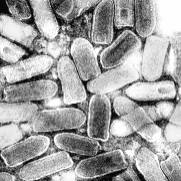Vesicular Stomatitis Virus

Vesicular stomatitis virus , purified from an infected cell culture. This is an important pathogenic virus of cattle, causing fever and vesicles in the mouth and on the feet. Negatively stained virions: note that they are clearly "bullet shaped" just like rabies virus. Magnification approximately x40,000. Micrograph from F. A. Murphy, School of Veterinary Medicine , University of California , Davis .
Incubation Period:
VSV has an incubation period of 2 to 9 days.
Transmission:
The virus is unable to penetrate intact skin or mucosa. It needs to be introduced beneath the skin and mucous membranes through wounds and abrasions. It can be transmitted by the bite of insect vectors (mosquitoes, sand flies, and black flies).
Epidemiology:
The virus is only present in the Western Hemisphere. The disease typically only affects horses, cattle, and swine. Human infection is most common in rural areas where the disease is enzootic. Enzootic areas include South Mexico, Central America, and some regions of South America. In the United States, Ossaaw Island, which is off the coast of Georgia, is the only area where VSV is enzootic. The disease is sporadic in the rest of the country. Historically, the disease appeared in a 10-year cycle. However, more recently, it has occurred more frequently. In temperate zones, outbreaks tend to begin in late summer and end at the beginning of winter. In tropical areas, outbreaks begin at the end of the rainy season and end at the beginning of the dry season.
Symptomatology and Outcome:
Lesions that are indistinguishable from Foot and Mouth Disease develop between 2 to 5 days after exposure. Infected individuals develop flu-like symptoms. They experience an acute onset of fever, chills, and muscle pain. The disease often resolves without complications within 7 to 10 days.
Prevention and Management:
Just like many other diseases, avoiding exposure is the most effective mode of prevention. Infected individuals usually rely on supportive care. Supportive care is also effective in the speedy recovery of infected animals. There is a vaccine for the virus, however, it is rarely used.
Reference:
"Fields Virology." Volume 1, 4th Edition. Lippincott Williams and Wilkins, 2001. pp. 1262-1264.